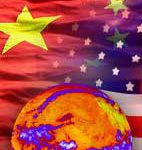In the recently published government document “China’s Policies and Actions for Addressing Climate Change”, China gave its full support to a new proposal that developed nations should contribute 1% of their GDP (equal to US$130 billion for the United States; US$160 billion for the European Union) to help poorer nations reduce greenhouse gas emissions. This new proposal is seen as one of China’s primary bargaining chips for the United Nations Climate Change Conference in Poznan, Poland, in December.
The western developed nations will inevitably reject this call, as they are only interested in including developing countries such as China and India in the ranks of those obliged to cut emissions. We can regard the 1997 Kyoto Protocol as establishing a fair but loose structural framework. However, this treaty provides no targets for the reduction of emissions from developing nations. When the main clauses of the protocol expire in 2012, humanity must negotiate another executable framework, either by improving on Kyoto or by starting again. This goal is the ultimate aim of another UN climate conference, to be held in Copenhagen, Denmark, in December 2009.
The United States chose not to be included in the original Kyoto Protocol, despite being the world’s largest emitter of greenhouse gases. While the Kyoto agreement did set targets for emission reductions against 1990 levels in developed nations, it did not define a plausible and quantifiable method by which to calculate emissions. This omission has led to disputes over monitoring, confusion over data and the shifting and shirking of responsibility.
In addition, Kyoto’s joint implementation mechanism (JI), clean development mechanism (CDM) and emission trading mechanism all contain loopholes, weak implementation, a lack of a penalty system and a failure of developed counties to cooperate on technological transfer. In short, the protocol’s legacy will be more spiritual than practical.
The Americans have always explained their opposition to the Kyoto Protocol in terms of its failure to require developing nations to cut emissions. According to calculations by the World Resources Institute, China’s carbon dioxide (CO2) emissions increased 108.3% from 1990 to 2004, compared with 87% in India and 67.8% in Brazil. Russia saw a decrease in emissions of 24.8% due to its economic collapse, while US emissions grew 19.8%.
It can be inferred that China is aware of the potential pitfalls at the Copenhagen meeting. Many predict that the world as a whole will demand that China accepts emission-reduction obligations. This call for action perhaps will be one of the most important markers of the post-Kyoto era. The United States was once the target for condemnation by environmentalists, but with the election of Barack Obama, we may see a change in that role. In comparison with his predecessor, George W Bush, Obama is a strong environmental advocate and a sort of spiritual ally of former vice-president Al Gore. Obama has indicated that the country will establish a compulsory greenhouse gas emissions trading system similar to a CO2 trading system.
China came under huge pressure at the UN climate conference in Bali, Indonesia, in 2007 — not just from the European Union, but also from within the developing nations. As it will be difficult in the post-Kyoto era for China to just ignore this pressure, the country must plan its next moves accordingly. It will be important to maintain the core of the spiritual legacy of the Kyoto Protocol in future negotiations. This legacy includes maintaining the system of common but differentiated responsibilities; pressuring developed nations to take the lead in funding environmental protection and proposing appropriate emissions reduction targets for developing economies.
We believe that the most important achievement of last year’s Bali roadmap was the establishment of an environmental protection fund for the poorest nations. The Chinese proposal that the European Union and the United States should contribute 1% of their GDP can be seen as an extension of that idea. In fact, rich nations’ contributions could even be broadened. China could propose a new global environmental fund, with each nation’s donations given in proportion to its historical contribution to pollution, rather than in proportion to its current GDP. Since the industrial revolution, developed nations have accounted for 95% of emissions.
This fund also would act as a kind of deterrent because if a nation did not meet its proposed targets, it would be forced to increase its contribution as punishment. This solution also would address the Kyoto Protocol’s greatest weakness by providing penalties for inadequate implementation of pollution measures.
In a paper entitled “China’s Participation in Global Environment Negotiations” published this October, economists Tian Huifang and John Whalley described the long-term outlook for China’s emissions. They predict that by 2010 China will account for 21.1% of global emissions and overtake the United States with its predicted rate of 20.1%. In 2020, China’s emissions are predicted to be 23.9% of the global total, with the United States accounting for 18.8%. By 2030, the figures are predicted to be 26.2% and 18.5% respectively.
Although we do not agree with these coarse linear extrapolations that exaggerate China’s future emissions, we should be aware that these underlying trends do exist. Therefore, China must fight to have its reductions targets based on 2007 levels, rather than as a percentage of global emissions or set in terms of emissions per capita. With the US financial crisis causing a global recession, the Chinese economy will see five years of decline and rapid drops in carbon emissions, which indicates that 2007 may be a peak value for years to come.
When it comes to transfer of technology, the developed nations have always preferred to transfer “low-end” technology. They believe that releasing the latest environmental technology will allow developing nations to reduce their manufacturing costs, thereby leading to increased production and carbon emissions. Technology transfers are aimed at maintaining current manufacturing levels and are exclusive of any transfers that may increase productivity. In short, wealthy nations hope that developing nations will meet environmental standards by reducing production rather than improving technology.
China, naturally, will disagree with this idea in no uncertain terms and should stress the assimilation and application of complete and innovative sets of technology. China should also advocate the formulation of standards to determine the level of technology transferred and connect that level to the amount of emissions awarded. Only in this way will the developed nations be persuaded to undertake genuine transfers of advanced technology and achieve sustainable development targets.
Tang Xuepeng is a senior editor at the 21st Century Business Herald. This article has been expanded and revised from the original with consent of the author and the 21st Century Business Herald.
Homepage photo by Sean Barnard




